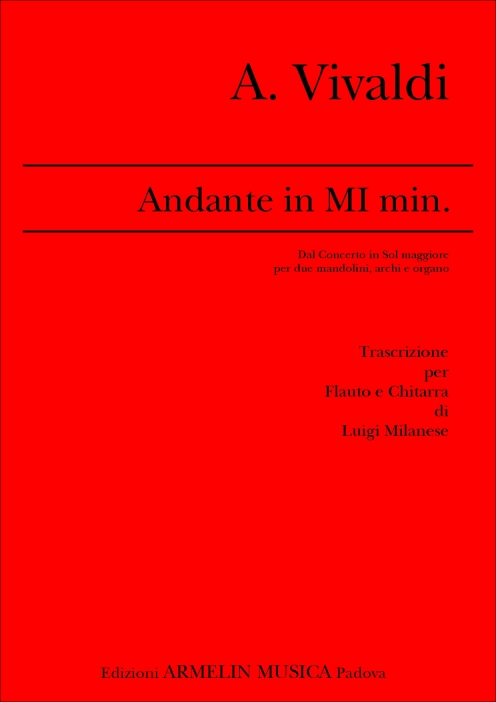Vivaldi, Antonio
1678-1741
Andante
Per flauto e chitarra
€12,00
Organico:
PDM 057
9790215810877
21x29,7
Armelin Musica
PREFAZIONE
Il contributo che la chitarra poteva offrire alla musica d’insieme ai tempi di Vivaldi era – come è noto – molto ridotto. I motivi erano principalmente due: da un lato la presenza di importanti strumenti a corda tradizionalmente impiegati sia in veste solista sia per la realizzazione del basso continuo, come il Chitarrone, la Tiorba e il Liuto, per il quale lo stesso Vivaldi scrisse importanti concerti. Il secondo motivo era legato al diffuso utilizzo della chitarra come “strumento popolare” il quale contribuì a creare intorno ad essa quel significato sociale che la rendeva poco adatta all’ interpretazione della musica colta. Il successivo sviluppo della chitarra – che coincise con il progressivo declino del liuto e delle chitarre antiche – permise allo strumento di inserirsi gradualmente nell’area della musica colta ed essere così utilizzato nella musica d’insieme, sia cameristica che orchestrale. Un ruolo importante nell’evoluzione della chitarra è senz’altro rappresentato dalle costanti e numerose opere di trascrizione che a partire da quelle effettuate dalle intavolature per Liuto, ha portato lo strumento ad avere oggi un’ importante bagaglio di composizioni cameristiche, oltre a quelle originali. Ed è in tale contesto che và ad inserirsi il presente lavoro. Non una trascrizione “tanto per trascrivere…” ma una trascrizione realizzata con l’obiettivo di offrire un contributo – spero importante – che renda ancor più ricco e variegato il repertorio cameristico delle sei corde; in questo caso insieme al flauto, incontro, tra l’altro, che ha sempre permesso al nostro strumento di esprimere al meglio le proprie potenzialità timbriche, dinamiche, e soprattutto polifoniche.
PREFACE
As everybody knows the contribution given by the guitar to the ensemble music in Vivaldi’s times was very small. Basically the reasons were the following two: on the one hand there was the presence of important string instruments traditionally used both as soloists and as continuos, such as the Chitarrone, the Thiorbo and the Lute, for which Vivaldi himself wrote important concerts. The second reason was linked to the widespread employment of the guitar as a “popular instrument” by giving it a particular social meaning not fit for the playing of cultured music. With the progressive decline of the Lute and the antique guitars, the ensuing development of the guitar allowed the instrument to become gradually integrated in the area of cultured music and be used in theensemble music, both chamber and orchestral one. An important role in the evolution of the guitar is represented no doubt by several steady transcription, that led the instrument to gain a noteworthy background made of chamber compositions, besides the original ones, starting from the tablatures for Lute. And the present work should be seen in this context. This is not a transcription “just for the sake of doing…”, but rather a transcription accomplished whit the target of giving a contribution – an important one, I hope- which could make the chamber repertoire of the six strings richer and more diversified; in this case, besides the match with the flute has ever allowed our instrument to express its timbre, dynamic and above all polyphonic potentialities at its best.
